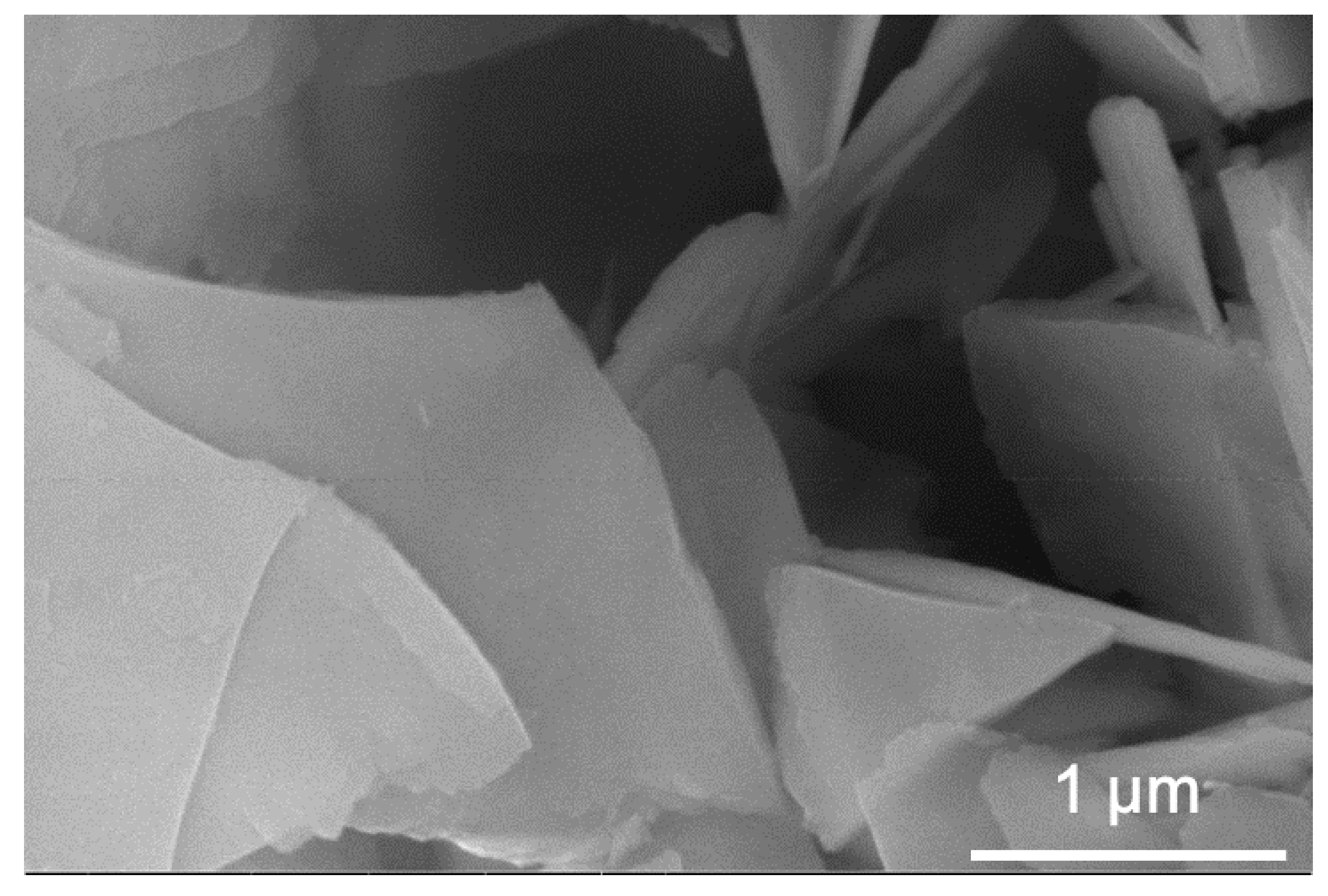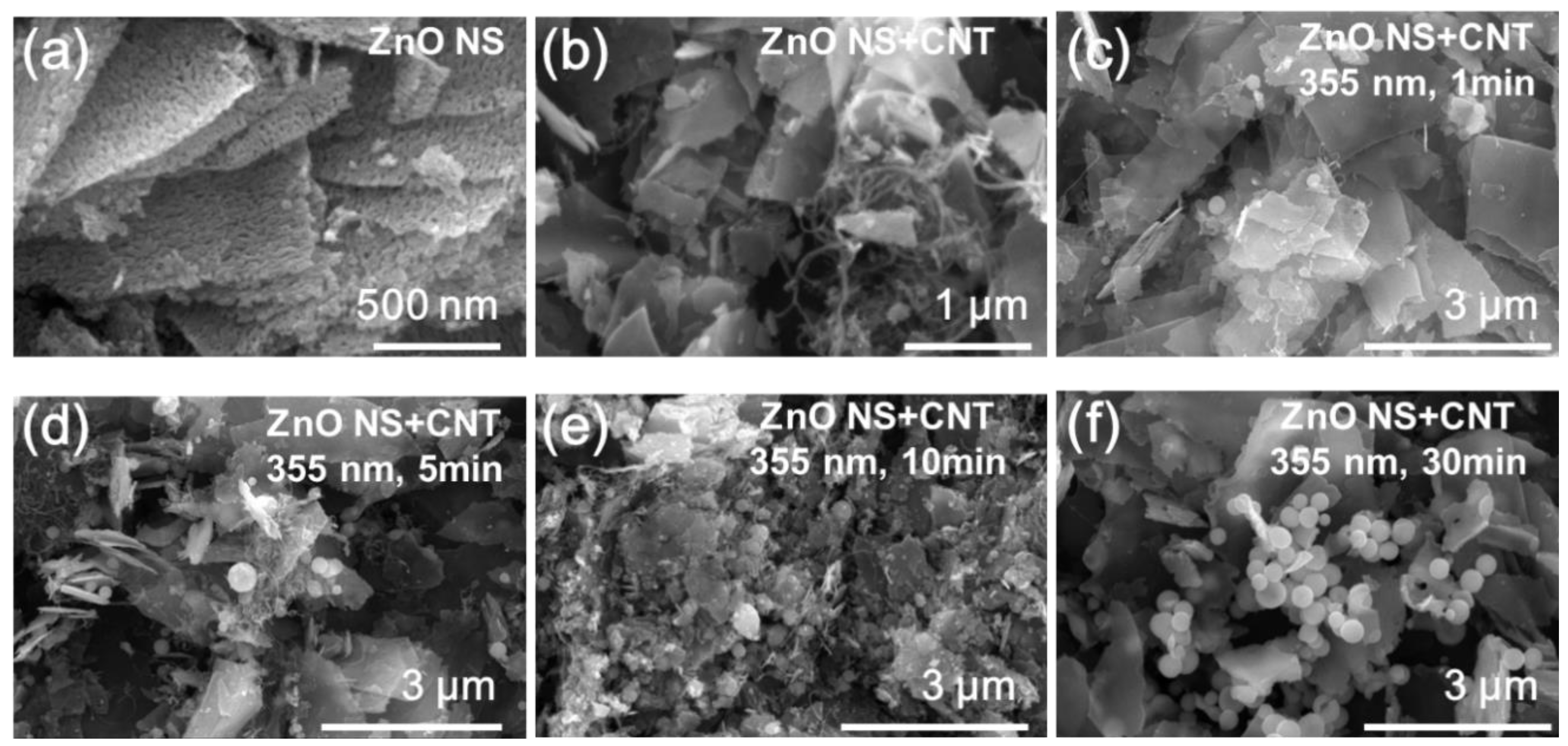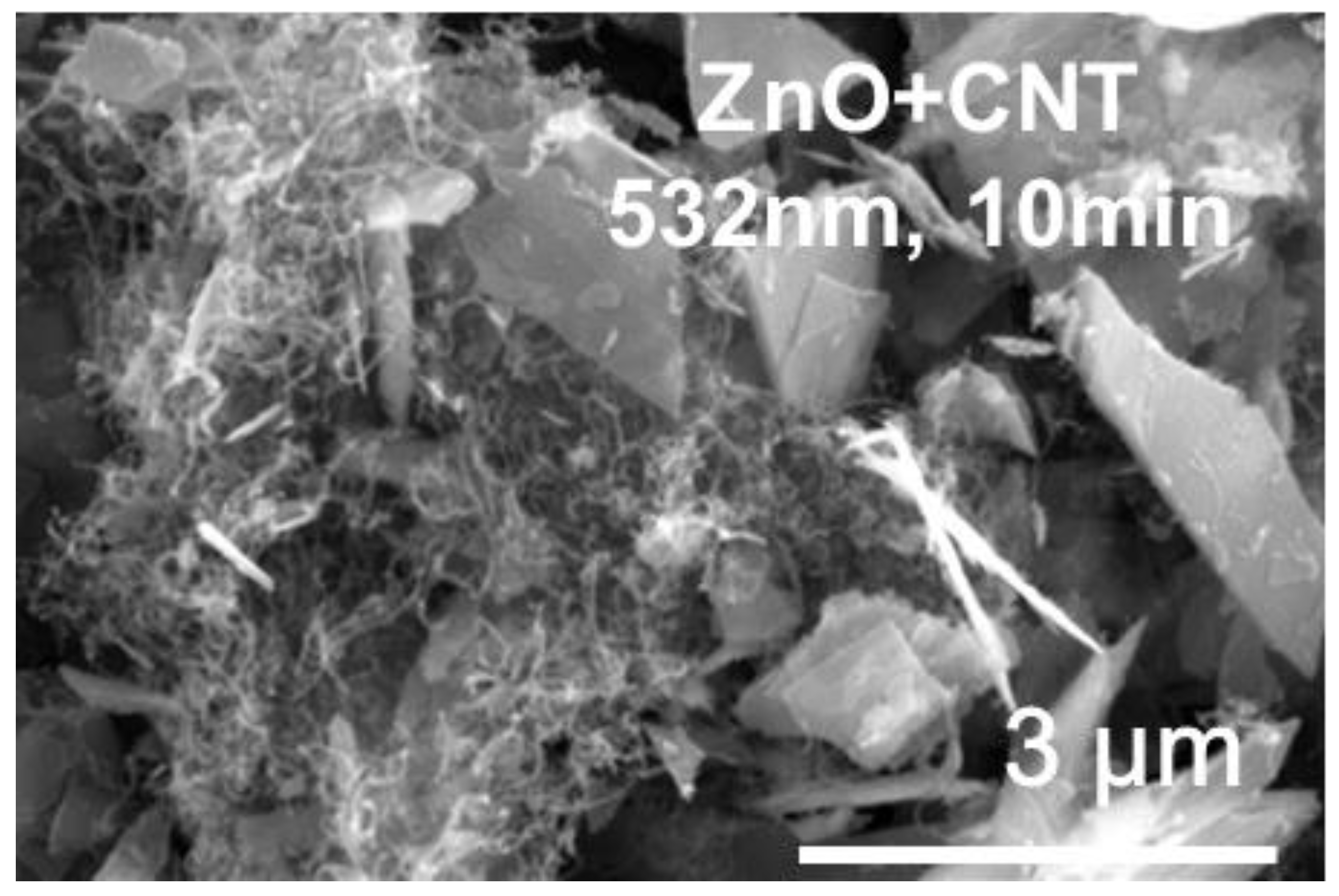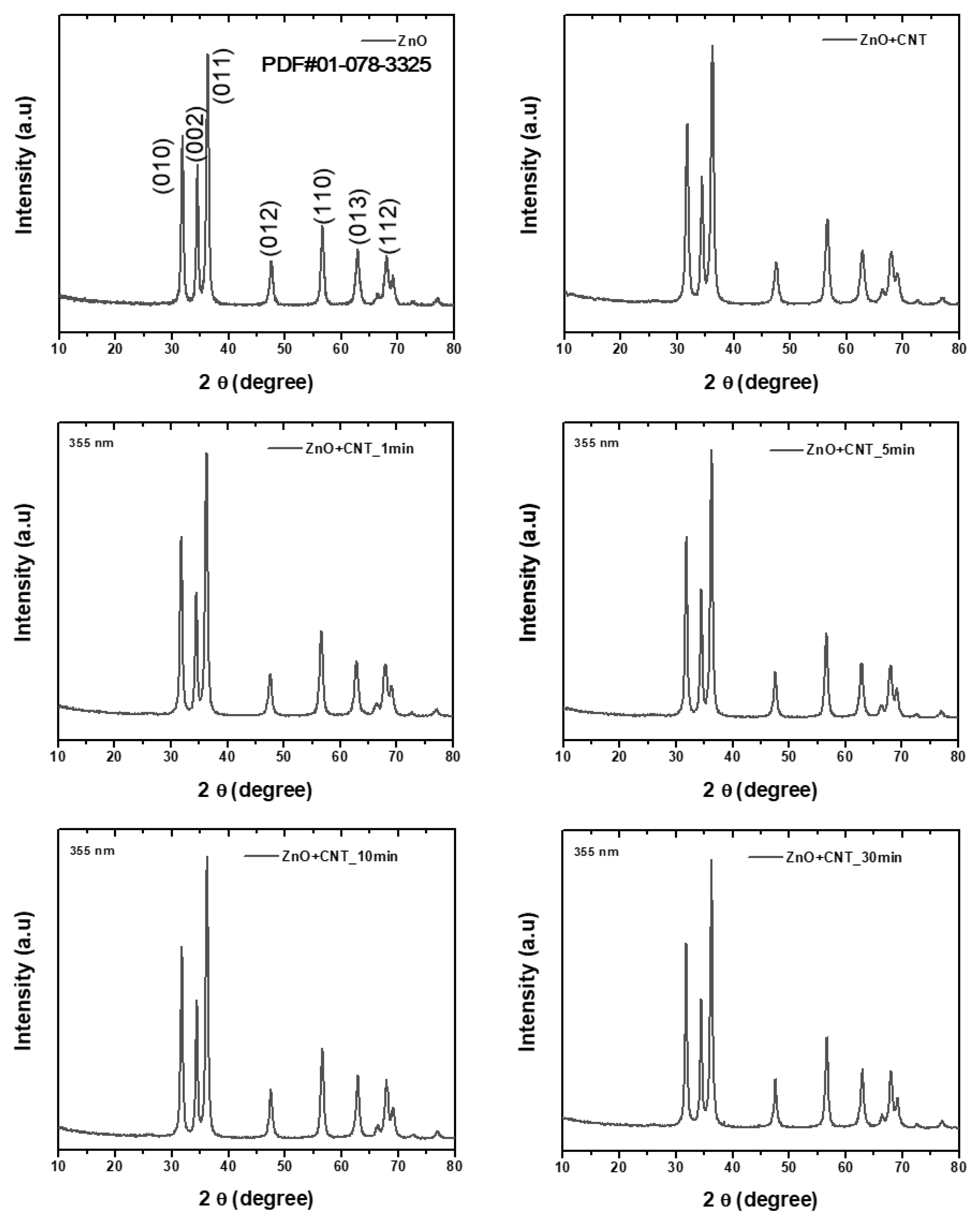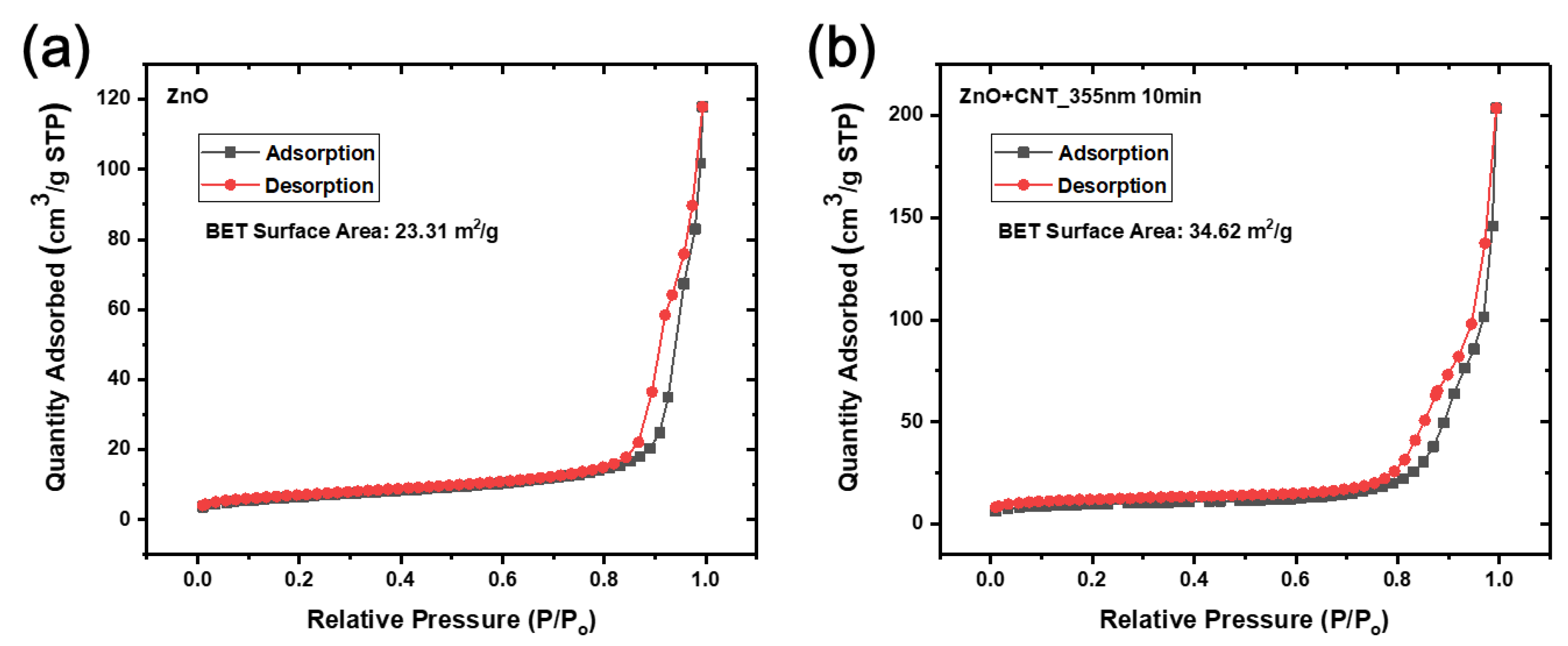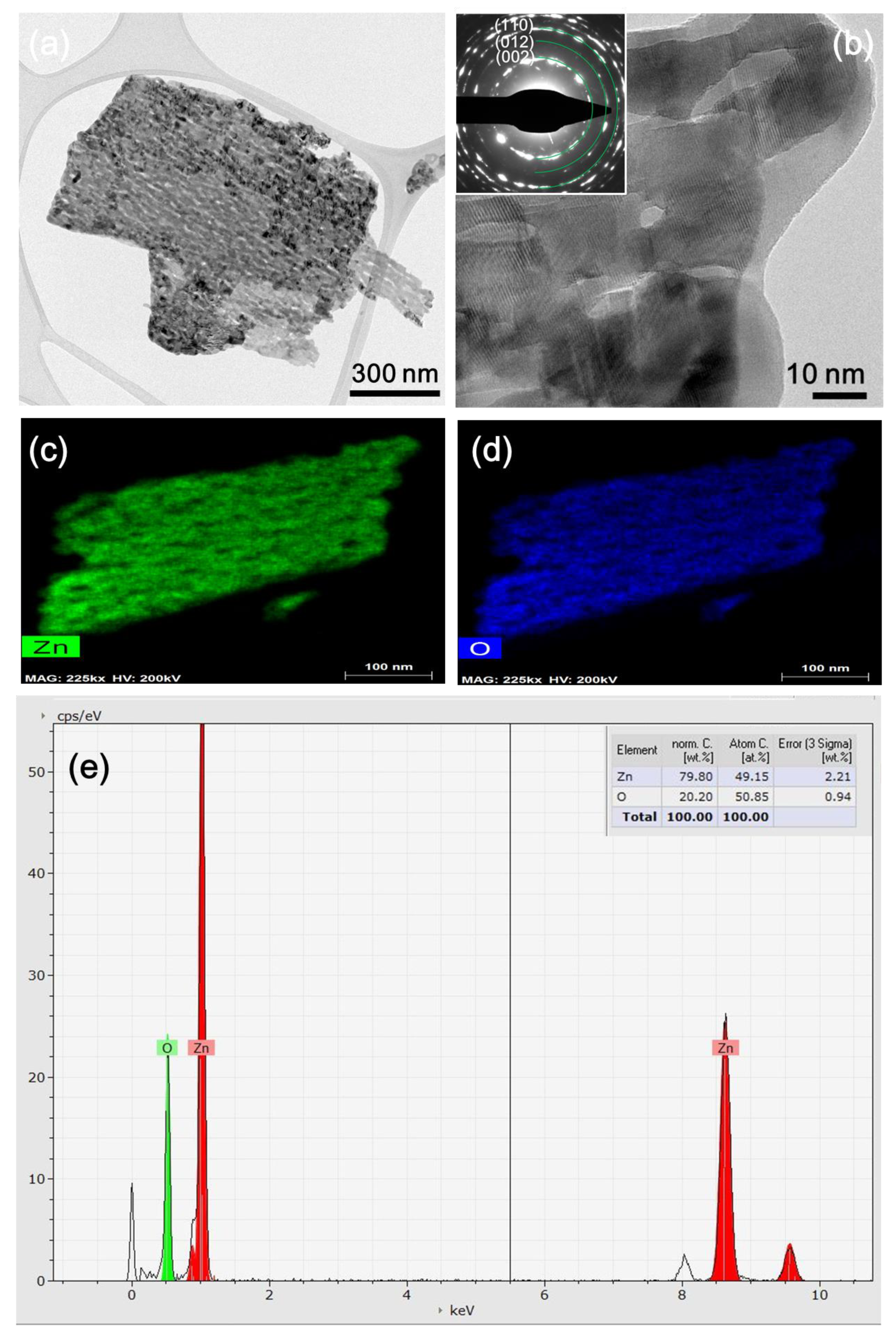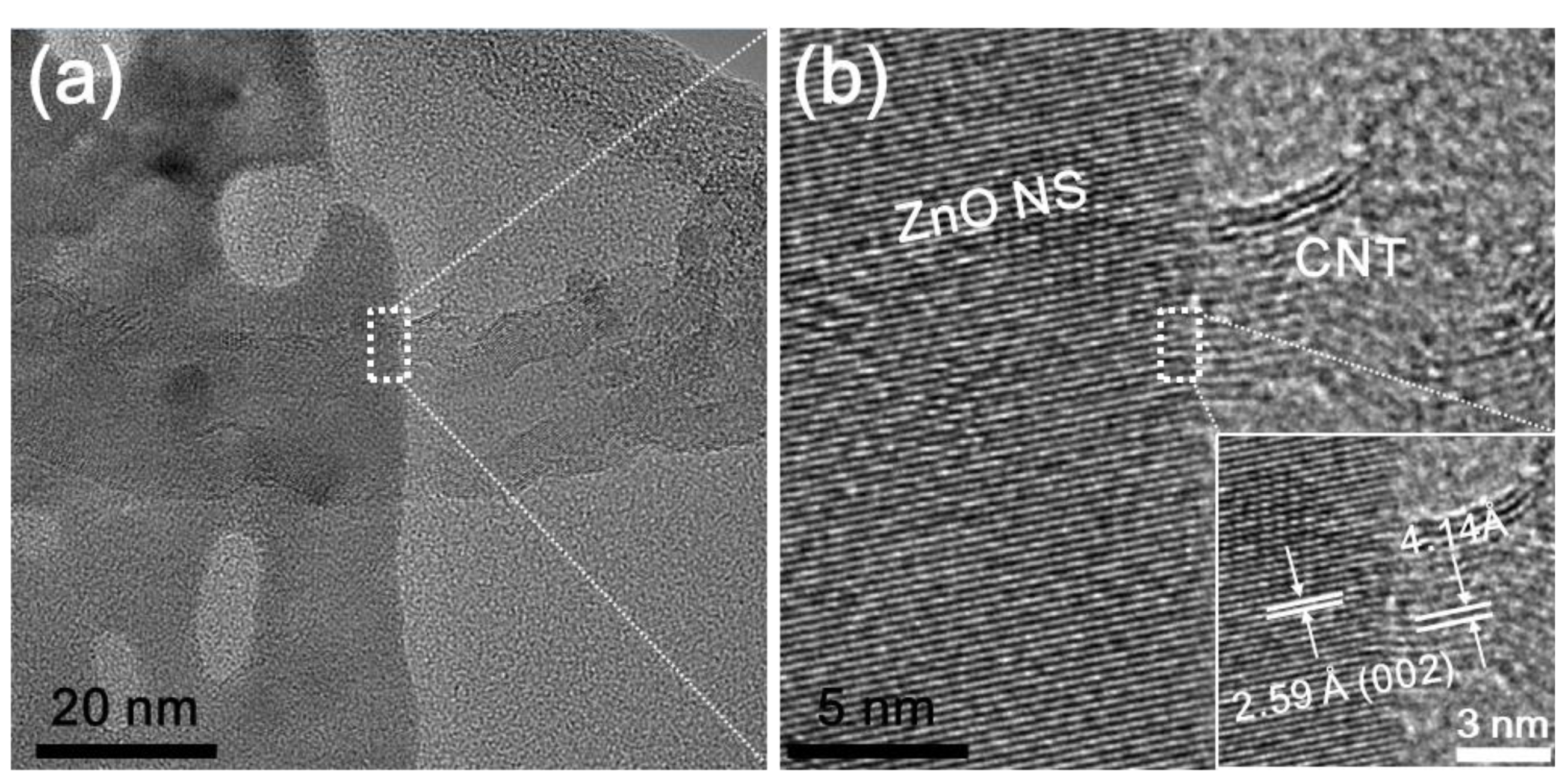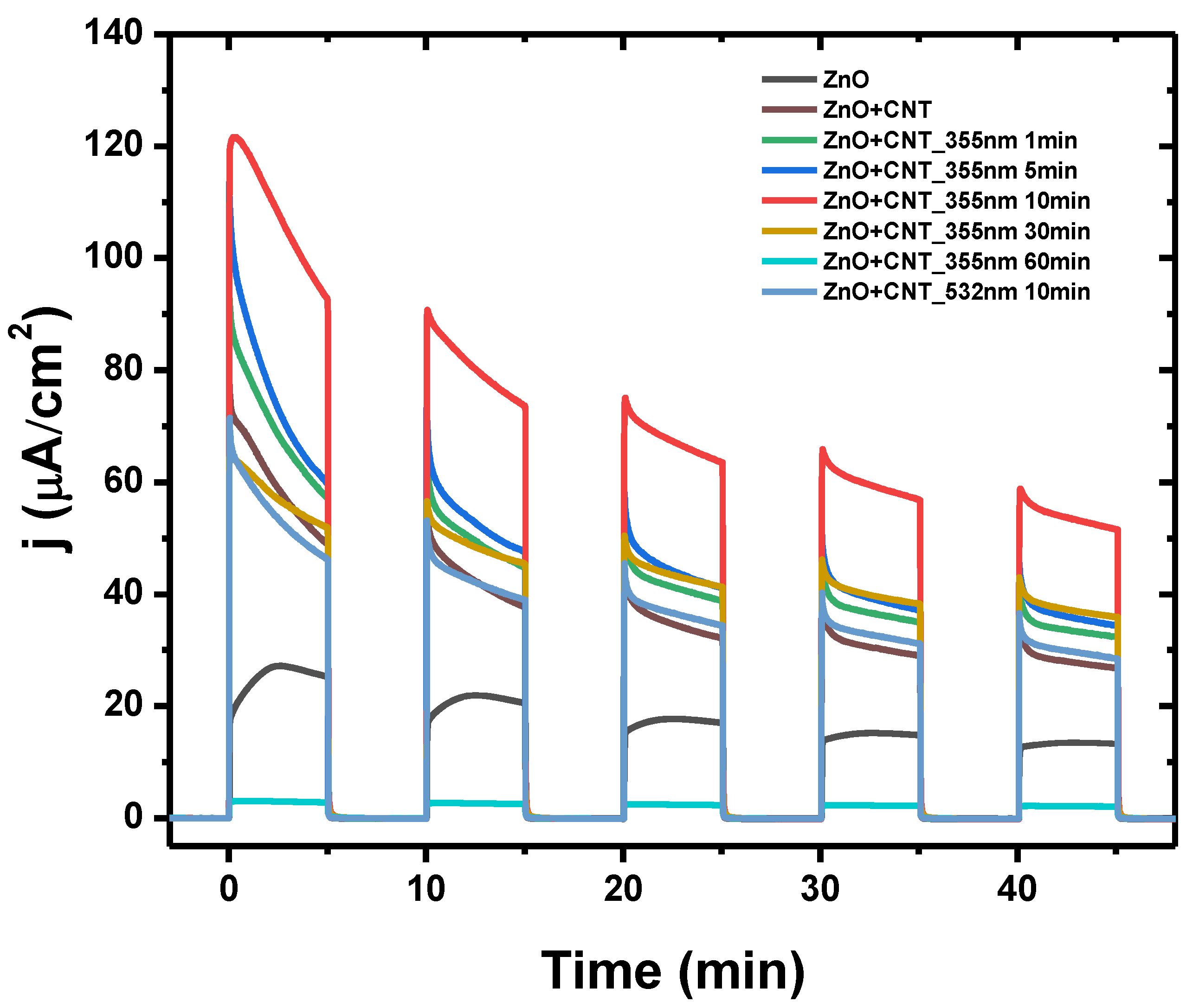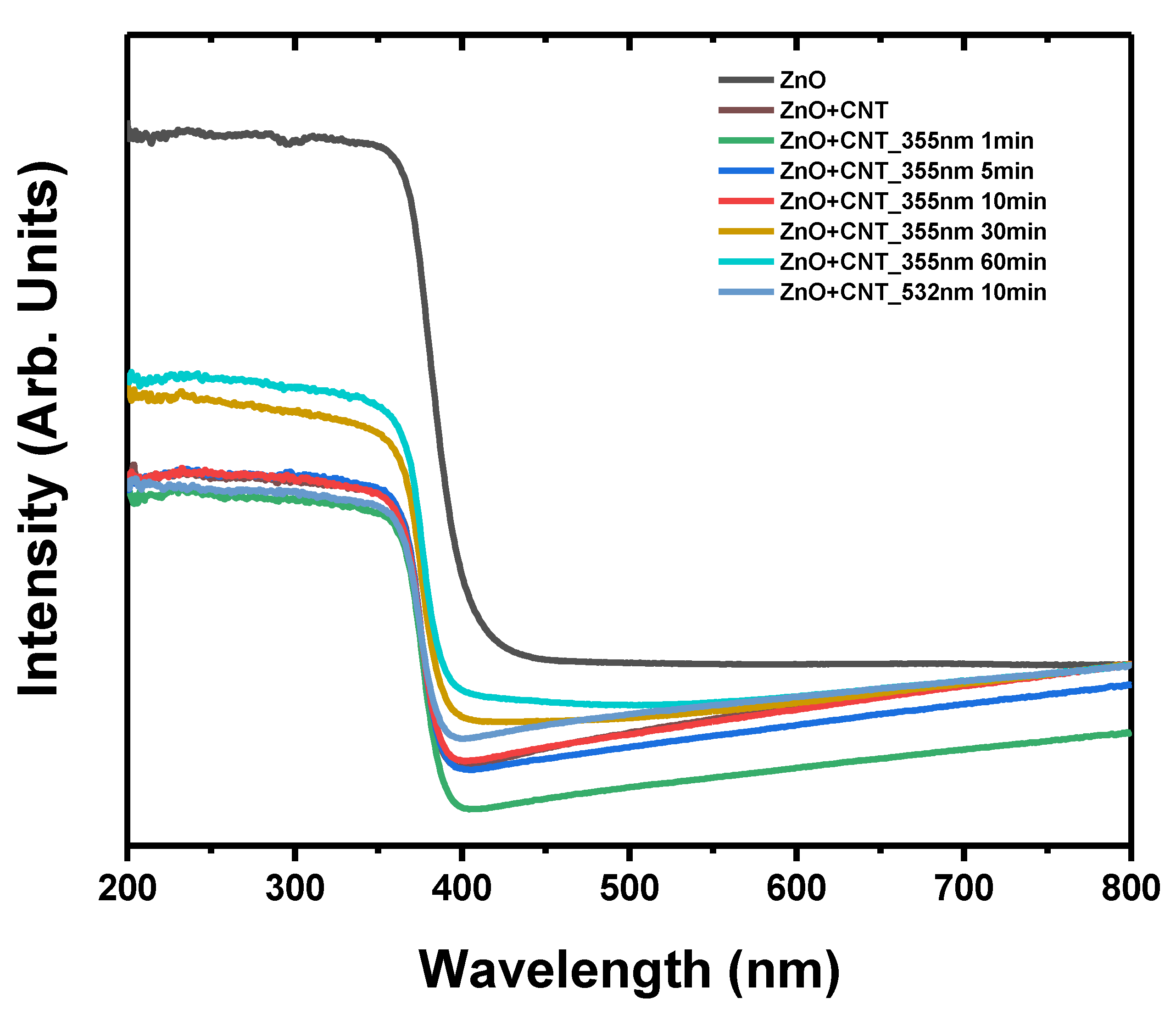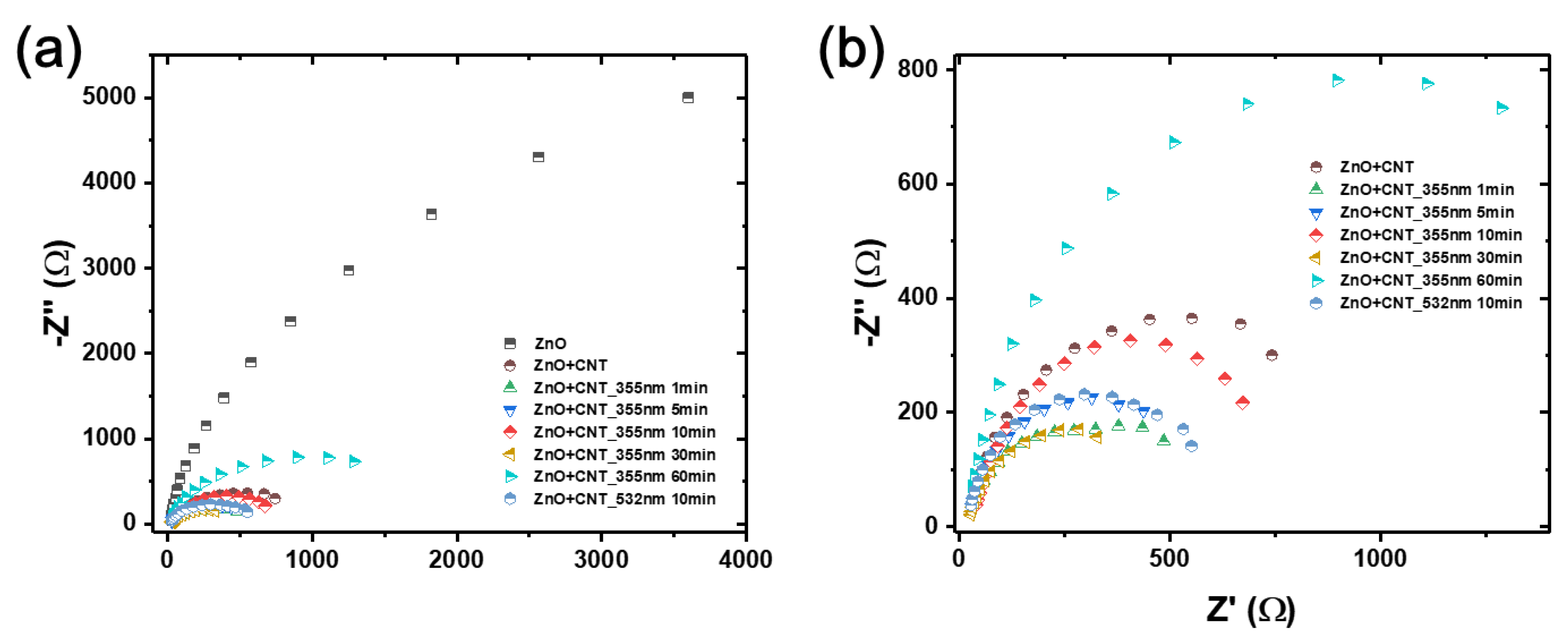1. Introduction
Photoelectrochemical (PEC) water splitting for hydrogen production has attracted great attention as clean and sustainable energy conversion technology after Fujishima and Honda first reported the hydrogen evolution reaction (HER) of TiO
2 via PEC water splitting [
1,
2]. Novel metal-based materials such as platinum (Pt), iridium (Ir), and ruthenium (Ru) are the most efficient catalysts for hydrogen production. However, their scarcity and high cost hinders the practical applications of novel metal-based catalysts towards mass production of hydrogen [
3,
4]. Therefore, tremendous efforts have been made on the development of earth-abundant and low-cost alternatives with excellent photocatalytic activity.
ZnO is regarded as a promising photocatalyst due to high electron mobility at room temperature, easy control of nanostructures, low-cost, and non-toxicity [
5]. However, a wide band gap and high recombination rate have limited ZnO as a high-performance photocatalyst in wide applications. Notably, highly conductive co-catalysts can effectively suppress charge recombination by modifying the electronic configuration of primary catalysts and prolong carrier lifetime. Carbon-based materials such as carbon nitride, graphene, or carbon nanotube (CNT) are some of the most promising co-catalysts thanks to excellent charge transport, high surface area, robustness, and low-cost. Hence, various hybrids comprised of semiconductive photocatalyst and conductive carbon materials have been intensively studied with an aim to replace expensive novel metal-based catalysts for water splitting [
6,
7,
8].
Wet-chemical routes are conventionally used to synthesize carbon-based composite materials, which often leaves acidic residues that needs to be purified for further application [
9,
10]. The synthesis of nanomaterials by pulsed laser ablation (PLA) has attracted significant attention [
11,
12,
13,
14]. PLA is able to downsize bulk particles into nanometer-sized structures within a few minutes. More importantly, PLA does not need to utilize highly acidic (e.g., KMnO
4, H
2SO
4) or basic aqueous solutions (e.g., KOH, HNO
3) [
10,
15,
16,
17]. Hence, PLA can be employed to synthesize nanocomposites in environmentally friendly and cost-effective way. PLA has been rarely studied for preparing high-performance photocatalytic nanocomposites due to its high potential. In addition, nanocomposites of ZnO and carbon based materials for photocatalysis have often been prepared via wet-chemical routes, which requires prolong synthesis time and multiple steps [
18,
19,
20,
21,
22]. To the best of our knowledge, it is first time that ZnO and carbon based nanocomposites for photoelectrochemical water splitting using a facile and cost-effective PLA technique have been developed.
Herein, we report a novel strategy to develop efficient photocatalytic ZnO nanosheets (ZnO NS) hybridized with carbon materials by using a PLA technique. We investigated the modulation of PEC properties of ZnO NS after carbon hybridization via PLA. Photocatalytic activity of ZnO NS was significantly enhanced after only 10 min of PLA process in water, resulting in homogeneously distributed carbon nanotubes (CNTs) on the surface of the ZnO NS. Based on the results, it was demonstrated that PLA is a highly promising technique to prepare efficient photocatalytic nanocomposites, especially with carbon-based materials.
2. Results and Discussion
Figure 1 shows field-emission scanning electron microscopy (FE-SEM) images of ZnO NS before calcination. As-prepared ZnO NS has a well-defined nanosheet structure with high surface area. After calcination, the morphology of the as-prepared ZnO NS became highly porous surface morphology which can be beneficial for enhancing photocatalytic activity (
Figure 2a). As a control experiment, ZnO NS was physically mixed with CNT; the SEM image is shown in
Figure 2b. Aggregated tubular CNT was found on the surface of ZnO NS. In contrast, after PLA process for 1 min, the CNT aggregates were not observed, indicating that successful ablation was achieved within 1 min of PLA processing (
Figure 2c). Interestingly, for further ablation (5 and 10 min), ZnO NS was partially converted to round shape ZnO nanoparticles (NPs) (
Figure 2d–e) with well dispersed CNT. However, when the ablation time was increased up to 30 min, large amount of ZnO NP instead of ZnO NS was formed and no CNT was observed (
Figure 2f). This implies that CNT was completely transformed to graphene quantum dots (GQD) during the PLA process. In addition, PLA can facilitate the transformation of ZnO NS to NP, resulting in significant morphology change after PLA for 30 min. We also investigated the effect of laser wavelengths on the structural change of ZnO NS and CNT (ZnO NS-CNT) hybrids.
Figure 3 shows the SEM image of the ZnO NS-CNT hybrid ablated by a laser with longer wavelengths (532 nm) for 10 min. It was found that large amounts of CNT aggregates were still remaining on the surface of ZnO NS. Also, morphology change from ZnO NS to NP was not detected, indicating that sufficient laser energy is necessary to control the morphology of CNT or ZnO NS by PLA process.
Crystallographic structure of the ZnO NS-CNT hybrids was studied by XRD. The XRD patterns of all samples (ZnO NS, ZnO NS-CNT, ZnO NS-CNT (1 min), ZnO NS-CNT (5min), ZnO NS-CNT (10 min), and ZnO NS-CNT (30 min)) are shown in
Figure 4. Notably, the XRD patterns were well-matched with the standard XRD pattern (PDF# 01-078-3325) of the ZnO phase. The formation of the hexagonal wurtzite structure of ZnO was confirmed since the diffracted peaks at 31.85, 34.42, 36.30, 47.58, 56.73, 62.87, and 68.11° can be indexed along the (010), (002), (011), (012), (110), (013), and (112) planes of the phase. No secondary phases were observed for ZnO NS or ZnO NS-CNT hybrids demonstrating that the PLA process has the advantage of preparing ZnO and carbon composites with a controlled crystal phase and structure within a very short time. Nitrogen adsorption–desorption isotherm was performed for the ZnO NS and ZnO NS-CNT hybrid to estimated surface area. As shown in
Figure 5, BET surface areas of 23.31 and 34.62 m
2g
−1 were measured for ZnO NS and ZnO NS-CNT hybrids, respectively. Interestingly, the BET surface area was slightly increased after hybridization, possibly due to the partially ablated CNT tubular structure. The larger surface area of ZnO NS-CNT hybrid may be beneficial for enhancing photocatalytic activity by facilitating mass or charge transport during electrolysis.
Transmission electron microscopy (TEM) was utilized to investigate structural characterization of as-synthesized ZnO NS and ZnO NS-CNT hybrids.
Figure 6a shows low-resolution TEM images of ZnO NS, where two dimensional (2D) porous nanosheet structure is clearly observed. High-resolution TEM (HR-TEM) with corresponding selective area electron diffraction (SAED) images revealed that the synthesized ZnO NS has polycrystalline structure crystallized in a distinct hexagonal wurtzite ZnO phase (
Figure 6b). Energy dispersive X-ray (EDX) spectroscopy was performed in order to acquire elemental distributions in the sample.
Figure 6c,d shows EDX mapping images for Zn and O in the ZnO NS sample, respectively, where homogeneous elemental distributions are clearly presented. In addition, quantitative EDX spectra analysis demonstrated that Zn and O have atomic ratios of about 1:1, which is inconsistent with XRD and TEM results (
Figure 6e).
Figure 7 shows the HR-TEM images of the ZnO-CNT hybrid after a 10 min PLA process. The distinct 2D porous nanosheet structure had remained after the PLA process (
Figure 7a). Furthermore, the formation of the ZnO NS and CNT hybrid was clearly observed, as shown in
Figure 7b; a lattice fringe of 2.59 Å, corresponding to (002) of ZnO, was presented in junction with that of the layered CNT (lattice fringe of 4.14 Å).
Photoelectrochemical Characterization
The transient photocurrents of the samples were measured under on/off illumination cycles.
Figure 8 shows that ZnO NS-CNT hybrids exhibit reproducible and immediate responses to irradiation. The photocurrent of samples rapidly increases to the maximum value under light, and it immediately drops to near-zero when the light is switched off. The photocurrent of ZnO NS is around 20 μA cm
−2 while that of ZnO NS-CNT hybrids are about 2–4 times higher. The enhanced photocurrents of ZnO NS-CNT hybrids can be related to the improved charge transport via highly conductive CNTs. As the ablation time increases up to 10 min, the PEC performance of the ZnO NS-CNT hybrid was enhanced, and reached the highest photocurrent (120 μA cm
−2). However, for further ablation, the photocurrent of the sample was abruptly decreased. The ZnO NS-CNT hybrid ablated for 60 min exhibited significantly lower photocurrent (3 μA cm
−2) than that of pristine ZnO NS (20 μA cm
−2). These results indicate that the formation of ZnO NP may not helpful for enhancing PEC performance of ZnO-CNT hybrids. In addition, well dispersed CNTs onto ZnO NS is important to achieve high photocatalytic activity of the ZnO-CNT hybrid. In addition, the ZnO-CNT hybrid ablated for 10 min using the laser with the wavelength of 532 nm exhibited a lower photocurrent (60 μA cm
−2) than that of the ZnO-CNT hybrid ablated for the same time using the laser with the wavelength of 355 nm photocurrent (120 μA cm
−2). Thus, the optimal PLA condition to synthesize a ZnO-CNT hybrid with high photocatalytic activity can be determined as 10 min of ablation time using the laser with wavelength of 355 nm. Too long an ablation time induces an inactive photocatalytic phase (i.e., ZnO NP) while insufficient ablation energy may hamper the obtaining of well-dispersed CNTs with a high surface area onto the 2D porous ZnO NS.
Figure 9 represents UV–vis absorption spectra of the ZnO and ZnO NS-CNT hybrids. A strong absorption at the wavelength shorter than 400 nm was found for all samples related with the intrinsic bandgap absorption of ZnO [
5,
6,
8,
12]
. Although ZnO generally shows absorption peak near at 380 nm, the absorption peak at 380 nm was not observed for the samples possible due to hybridization effects between nanoporous ZnO nanosheets and nanostructured carbon materials of CNT. Notably, the optical absorption for UV as well as visible light regions was decreased after hybridization with CNTs. Although absorption for the visible light region was slightly increased after hybridization, the absorption for UV region was significantly decreased, as shown in
Figure 9. Thus, although precise calculation for the total absorption may be difficult for the ZnO-CNT hybrids, the total absorption may decrease after hybridization. Therefore, the enhanced photocatalytic activities of ZnO NS-CNT hybrids are difficult to be explained by optical properties, indicating that in-depth study on the modulations of electrochemical properties after hybridization via PLA need to be considered.
Charge transport behavior at the interface between photoanode and electrolye was investigated by electrochemical impedance spectroscopy (EIS). Nyquist plots of the ZnO NS-CNT hybrids are presented in
Figure 10a. Noted that the arc in the Nyquist plot is associated with the charge transfer process at the interface between electrode and electrolyte. Generally, lower interface resistance (i.e., facile charge transfer) is represented as smaller arc radius in the Nyquist plot. ZnO NS-CNT hybrids exhibited substantially lower interface resistance than pristine ZnO NS (
Figure 10a), which can be attributed to the high conductivity of CNTs. However, a ZnO NS-CNT hybrid ablated for 60 min showed significantly larger interface resistance than that of ZnO NS (
Figure 10b). This indicates that ZnO NPs formed during prolonged ablation may have intrinsically low conductivity (i.e., an insulating phase). In addition, a one dimensional (1D) tubular structure of CNTs is more suitable as a facile charge transport tunnel compared to zero dimensional (0D) GQDs, arising from the complete transformation of CNT to GQD during the prolonged PLA process. These results demonstrated that PLA is an effective tool for hybridizing ZnO NS photocatalyts with conductive CNT while maintaining the advantages of each phase.
3. Experimental Section
3.1. Chemical Reagents
All chemicals were purchased from Sigma-Aldrich Inc. and used as is without further purification.
3.2. Synthesis of ZnO NS
0.68 g of ZnCl2, 0.3 mL of NH4OH, and 0.7 g of hexamethylenetetramine (HMTA) were dissolved in 50 mL of DI water by stirring. The prepared solution was transferred to a Teflon-lined stainless steel autoclave and reacted at 150 °C for 5 h. The product was vacuum filtered and washed with Di water and ethanol for several times. The washed powder was dried in electrical oven at 70 °C under air. The powder was further calcined at 350 °C for 2 h.
3.3. Synthesis of ZnO NS-CNT Hybrids via Pulsed Laser Ablation
In a typical process, 100 mg of ZnO NS and 10 mg of CNT was dispersed in 400 mL of anhydrous ethanol using ultrasonication. A Q-switch ND:YAG laser system was employed at room temperature and in the air. The suspension, which forms a vertical water column, was ablated by a horizontal pulsed laser beam (355 and 532 nm, third harmonic, 10 ns pulse width) at a repetition rate of 20 Hz. The pulsed laser beam was focused to a diameter of around 1 mm with an ablation energy of 0.1 J.
3.4. Structural Characterizations
To investigate morphology of the samples, scanning electron microscopy (SEM; S4800, Hitachi, Tokyo, Japan) was employed. Transmission electron microscopy (TEM; Talos F200X; Thermo Fisher Scientific) equipped with an energy dispersive X-ray (EDX) was also utilized to study structural and compositional characteristics of the samples. For studying crystal structure of the samples, powder X-ray diffraction (XRD) technique was employed using Cu-Kα radiation (λ = 0.15418 nm) at 40 kV and 100 mA (D/MAX-2500/PC, Rigaku, Tokyo, Japan). The specific surface area of the samples was calculated by nitrogen adsorption–desorption measurements (TriStar II 3020; MicroMetrics, Norcross, GA, USA) and the Brunauer–Emmett–Teller (BET) surface areas of the samples were obtained.
3.5. Photoelectrochemical Characterizations
A standard three-electrode cell was used to measure the photoelectrochemical properties using a potensiostat (Autolab PGSTAT; Metrohm, Herisau, Switzerland). Graphite and standard Ag/AgCl electrodes were used as counter and reference electrodes, respectively. For the working electrodes, 10 mg of sample powder was added to 1 mL of Liquion solution, which was subsequently sonicated for 1 h and stirred overnight. The solution was then spin-coated onto a fluorine doped tin oxide (FTO) glass substrate and dried in an oven (60 °C) overnight. 0.5 M Na2SO4 solution as an electrolyte was prepared for the photoelectrochemical measurements. Xe lamp (300 W, 280–700 nm) was used to irradiate the working electrodes. Electrochemical impedance spectroscopy (EIS) was employed to calculated charge transfer resistance of the samples (Rct). The frequency range of 0.01–105 Hz under an AC applied voltage of 5 mV was investigated for EIS. Electrochemically active surface area (ECSA) of the samples were calculated by cyclic voltammetry (CV) measured over a potential range from 0.46 to 0.56 V vs. RHE. Based on CV data, the electrochemical double layer capacitance (Cdl) was calculated. To be specific, scan rates were changed from 20 to 100 mV s−1 and the difference in current density between anodic and cathodic sweeps (ΔJ = Janodic − Jcathodic) at the middle of potential range was used to calculated Cdl; the slope for ΔJ vs. scan rate plot has linear relationship with the Cdl of sample.
3.6. Optical Property Characterization
UV–visible optical absorption spectra were collected with a V-699 (JASCO) spectrometer (Easton, MD, USA) with a reference of dry-pressed BaSO4 disk.
